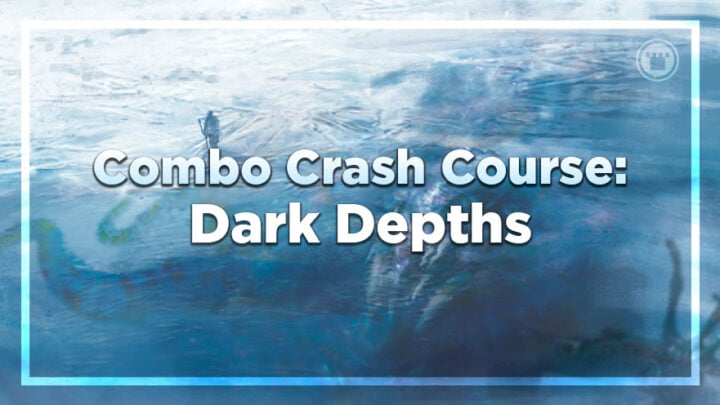Welcome back to Combo Crash Course, our semi-regular exploration of Magic’s greatest combo decks. This week, we’re kicking things up a notch in the power department. While previously, we’ve spent some time with famous combo decks from Standard, Historic and Modern, this will be our first time delving into the explosive combo potential of eternal formats like Legacy, Vintage, and Commander.
Increasing the size of the card pool tends to empower combo decks relative to other archetypes, and eternal formats have the largest card pools of all (every black-bordered printing is legal by default). Cards can be banned for balance reasons, or excluded due to format rules, but this still leaves a critical mass of powerful and unique cards from across three decades of Magic. Some of the strongest – and weirdest – combo decks arise here, as cards printed years apart synergize in ways their designers never expected…
WHAT IS DARK DEPTHS?
Dark Depths is one of the more unique combo wincons in Magic history. The namesake card is the rare non-mana-producing utility land, which tempts players with an instantly-lethal flying monster – all for the low, low price of… 30 mana. Ouch.
That’s way too much to pay for anything, but a 20/20 creature with flying and indestructible is worth getting a bit tricky for. And after some fortuitous printings years later in Zendikar and Gatecrash, combo players found their ways:
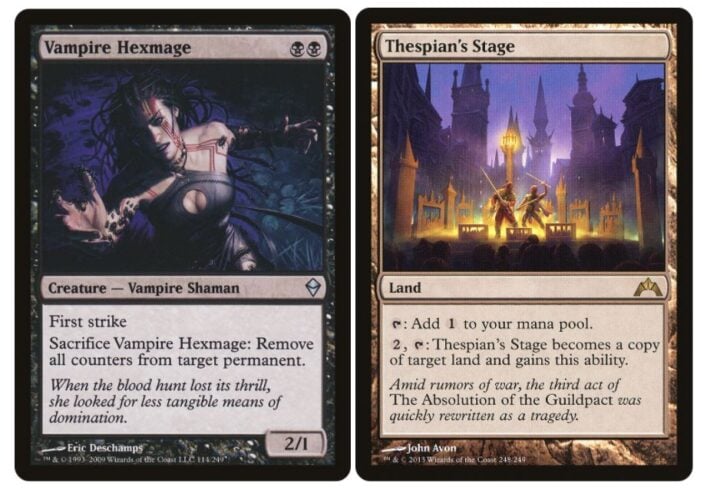
Vampire Hexmage was the first card other than Aether Snap capable of removing all ice counters from Dark Depths at once and summoning Marit Lage. Thespian’s Stage achieves the same result by targeting Dark Depths with its copy ability; Depths normally gets its ice counters as it enters the battlefield, so making a copy of it that’s already in play skips the counters and immediately unleashes Marit Lage. You do need to sacrifice both the original copy of Depths (to the legend rule) and Stage (to the Lage trigger), but the 20/20 is definitely worth it!
Both these combos are incredibly efficient, each costing a total of two mana to go from empty board to Marit Lage. From a deck building perspective, there’s a low opportunity cost – in non-combo situations, you’re far happier to draw a first strike blocker or extra land than a do-nothing sorcery. Best of all, you can fire off either combo at instant speed, which lets you unleash Marit Lage during your opponent’s end step and immediately untap and attack for the win.
These twin upgrades launched Dark Depths’ career as a combo powerhouse – one so strong that it was preemptively banned at the creation of the Modern format. But Dark Depths remained legal in older Constructed formats like Legacy and Vintage, where it was massively enhanced by the tutor power of Crop Rotation. Armed with this combination of instant combo and utility land toolbox, Dark Depths has become a stable pillar of the eternal metagame – and an often underappreciated Commander threat!
DIFFERENT DARK DEPTHS DECKS: A DEEP DIVE
Because this combo has such a remarkably low deck building requirement – just a handful of land slots – there’s a ton of flexibility in how you fill out the remaining deck slots. Most players will either choose to play green for Crop Rotation or black for Hexmage, and the classic Depths Combo builds have both. Beyond that point, you can break down the sub-categories of Depths deck by how many slots they dedicate to accelerating and protecting the combo: the Legacy community often recognizes “Slow Depths” and “Turbo Depths” as distinct archetypes.
Aside from Crop Rotation and Vampire Hexmage, the classic GB Depths Combo shell includes discard (Thoughtseize backed up by Duress or sometimes Inquisition of Kozilek), and Urborg, Tomb of Yawgmoth. Turning Dark Depths into a mana source is a great boost to the deck, particularly when that mana source can then cast Vampire Hexmage. Yavimaya, Cradle of Growth is also an option – being able to cast Crop Rotation off Depths feels terrific. You can usually expect a playset of Mox Diamond or other fast mana rocks to help with this part of the game plan.
From this point, Turbo Depths lists go all-in on fast mana, making use of Elvish Spirit Guide and Lotus Petal. Once Upon a Time acts as another free accelerant, finding Spirit Guide, Hexmage, Depths, Stage or Urborg as required. They also tend towards cards which can help punch through a win with their first Marit Lage, rather than try and reset: Rite of Consumption lets you win without attacking or finish off a player who survives the first hit, while Not of This World is a free counter that stops both Swords to Plowshares and Wasteland.
Slow Depths lists lean into more card advantage and interaction. While not as fast to “goldfish” (i.e. win against an opponent doing nothing), they can usually pressure opponents with a chain of 20/20’s while clearing away any defenses with Assassin’s Trophy and Abrupt Decay. Dark Confidant is the most popular draw engine, with Life from the Loam or Sylvan Library occasionally thrown in. Sylvan Safekeeper is the other iconic card for this build – while sometimes included in the protection package of Turbo Depths, it’s an even better fit for slower games.
WHITE IS THE NEW BLACK
The significant evolutions of the Legacy metagame over the past three years have given rise to a third major variant of the deck: Selesnya Depths. This deck leans even further toward midrange, incorporating a full creature toolbox around Green Sun’s Zenith, which can carry games where the combo is ill-suited or shut down.
Knight of the Reliquary is a particularly noteworthy gain here, especially in combination with Yavimaya, Cradle of Growth. Elvish Reclaimer has already made its way into many GB Slow Depths lists, and having four more souped-up copies of that effect only makes the game plan more consistent. This deck has become a refuge for Depths players whenever they feel the metagame is too hostile to the traditional combo, with options like Giver of Runes or Tomik, Distinguished Advokist available to take that protection even further.
GW Depths is sometimes considered to be a mashup of GB Depths and Maverick, Legacy’s classic creature toolbox deck. The low deck building cost of Depths + Stage makes it a prime suspect for sneaking into other archetypes like this, especially anything that can cast Crop Rotation.
Lands is usually regarded as a control deck, grinding opponents out by recycling powerful effects like Urza’s Saga, Blast Zone, Wasteland and The Tabernacle at Pendrell Vale. So playing Depths and Stage here is more about maximizing all the land synergies and enablers you already have rather than rushing out a 20/20 ASAP. Still, having the potential to Crop Rotation into the combo adds an important dimension to a deck which otherwise leans on very slow kills like Punishing Fire + Grove of the Burnwillows or Valakut Exploration.
Lastly, I have to shout out the awesomely-named “Black DETH” (for DEpths+Tendrils+Helm). This unique fringe deck combines the fast mana and tutors of Turbo Depths with several other lethal combos to present a quick and flexible attack, and allow for swapping out of win conditions to confound enemy sideboarding. There are even more viable ways to make a 20/20 flyer in Legacy, but hopefully this sample is enough to demonstrate the flexibility of the Dark Depths package.
HOW TO BEAT IT?
Dark Depths has many natural advantages, but the thing that really lands it in the top tier of combo decks is the way it utilizes lands. Land cards are simply overpowered when used as a vector of attack, since the design of Magic usually protects them from interaction. Dark Depths cannot be counterspelled, Thoughtseized, or targeted by most of the popular removal in eternal formats (Assassin’s Trophy and Wasteland being key exceptions). The same is true of Thespian’s Stage, and while Vampire Hexmage is vulnerable to countermagic, the sacrifice ability makes it very hard to stop once it resolves. Marit Lage herself is slightly easier to find answers for, but the combination of indestructibility, huge stats and a possible Crop Rotation for Sejiri Steppe makes her a tricky target as well. Non-targeting removal like Liliana’s Triumph is better, but can still be blanked by Crop Rotation (this time for Khalni Garden or Dryad Arbor).
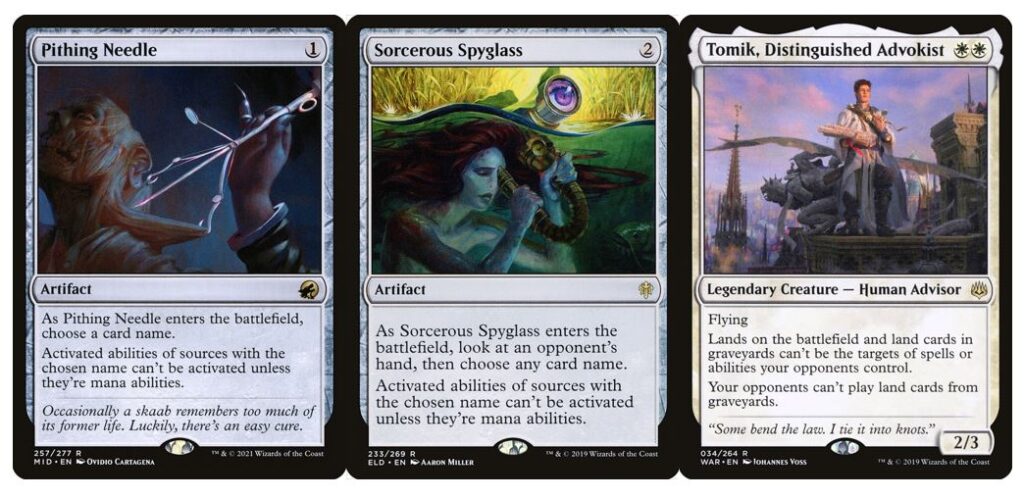
Land destruction, instant creature removal and flying blockers are your most reliable answers, but you need to layer those defenses to prevent them punching through for the one-shot kill. Depths really doesn’t have much card draw to keep up when trading cards, so just keep throwing up barriers and try to stay a step ahead of their disruption and protection. Permanent hate like Pithing Needle, Sorcerous Spyglass or Tomik, Distinguished Advokist can be very effective, forcing the Depths player to draw into their limited removal before they can threaten you again. Even gaining a single point of life somewhere in the course of the game can buy you a critical extra turn, since Marit Lage can’t scale up her damage the way something like Tendrils of Agony would.
The mana efficiency and flexible tempo of Depths Combo also makes it challenging to strategize against. The threat of a 20/20 attacker appearing in your end step creates tremendous pressure to hold up removal, but slowing down the game gives them time to pick that removal out of your hand, set up protection for their token, or just grind you out with their card advantage engines. On the other hand, rushing to use removal proactively will often lead to it being negated or even lethally blown out – Crop Rotation in response to Wasteland is the favorite line of many Depths players.
However, besides the occasional Not of this World out of Turbo Depths, this is one Legacy match-up where you don’t have to worry about free countermagic. So generally, you should be able to measure your window for interaction by just looking at what resources they keep available. If the Depths player taps their green source, you can rule out the defensive Crop Rotation. If they don’t have Hexmage or Stage on board yet, you know the punishment for attempting to remove Depths will be minimal.
In longer games, you can potentially run them out of certain cards altogether. They need to sacrifice Dark Depths every time they go for the combo, and in many cases, there are only one or two Safekeepers or Abrupt Decays in the whole deck. The GB builds in particular lack any serious plan B, so if you’re aware of their tricks and play tight against any sneaky combo window, then this can be a relatively winnable fight.
Before we move on, two PSAs about how NOT to beat Depths. Firstly, be wary of using Blood Moon or similar cards to counter the combo. They allow Dark Depths to enter play without ice counters, meaning an immediate free 20/20 if the Blood Moon effect is ever lifted. Secondly, never try to use Stifle or similar cards to counter the creation of Marit Lage. That triggered ability is state-based, meaning it will go right back on the stack so long as its conditions are still met. Stifle the ability of Vampire Hexmage or Thespian’s Stage instead. Or better yet, Stifle the ability of Elvish Reclaimer when it tries to fetch up Depths in the first place!
THE COMMANDER QUESTION
For all the reasons we’ve explored above, Dark Depths is among the most powerful combos in eternal formats. And yet in Commander, the most popular eternal format of all, it isn’t nearly as popular. Unfortunately for Marit Lage fans, a 20/20 flyer just doesn’t scale up to a multiplayer 40-life format the way infinite combo kills do, and that seems to be where the discussion ends for most players.

But we shouldn’t write off a combo this efficient and compact – remember, Depths + Stage can go in anything, and you can throw in Mirage Mirror as another colorless combo piece! In a casual environment, the fact that this combo won’t immediately kill the table could very well be a positive thing, while still providing an entertainingly large threat. And for more competitive brewers… well, there are ways to give our Avatar token a little help.
As essentially a 20/20 flash flyer for two, Marit Lage is an incredible rattlesnake against anyone looking to attack you for triggers or chip damage, and can be developed relatively safely at the end of a turn cycle to pressure opponents. Even as a two-turn clock, she still demands ramp and combo decks slow down for a turn to deal with her. And if they don’t, buffing her with double strike or infect will teach them some respect in a hurry.
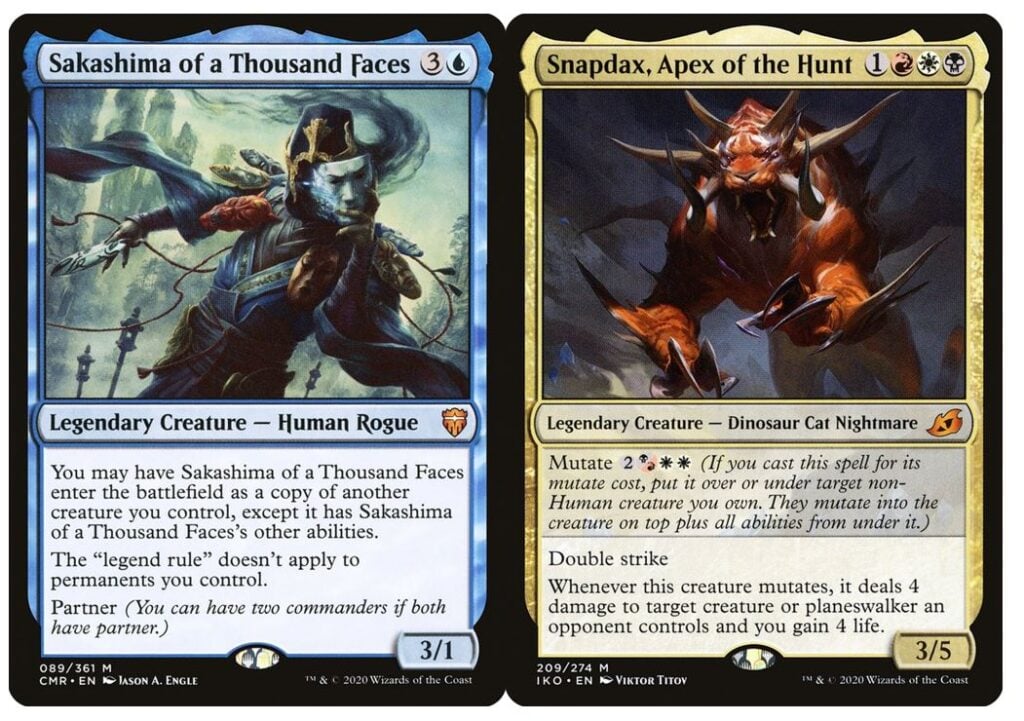
There’s also plenty of Commander-specific options for getting extra value from Dark Depths. Sakashima of a Thousand Faces opens up the possibility of cloning both Dark Depths and Marit Lage, multiplying the value of your early 20/20. Any commander with a mutate ability makes Dark Depths extremely threatening – any mutated creature “stack” which contains your commander counts as your commander, even when it’s not the card on top. So you can make Marit Lage in an opponent’s end step, untap, mutate Snapdax, Apex of the Hunt underneath it, and immediately swing for 40 commander damage in the air!
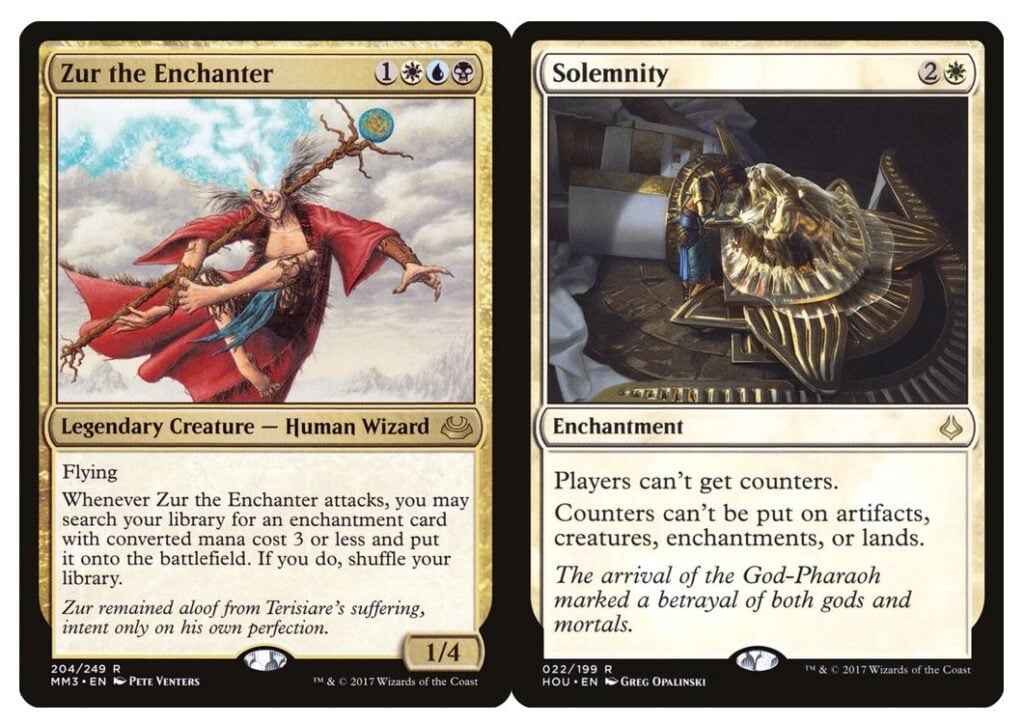
Zur the Enchanter doesn’t really need more nutty things to do, but it’s worth noting that Solemnity is another way to generate an immediate token out of Dark Depths. Temmet, Vizier of Naktamun, Neyith of the Dire Hunt and Xenagos, God of Revels all adore having access to such a huge and indestructibly safe attacker for such a cheap price. Then there’s any number of commanders who benefit from putting a giant creature on board right before you untap, those who can easily recycle the combo pieces, and so on. So long as you think of it as a uniquely efficient creature threat and not an instant kill, plenty of decks can get a boost from this Legendary Snow Land.
BREAK THE ICE, START THE PARTY
Thanks to a remarkable combination of iconic artwork, flavorful design, powerful synergy and a unique attack vector, Dark Depths has cemented itself as one of the most enduring and beloved combo decks in Legacy (and Vintage!). Were it not banned in other formats (and mostly overlooked in Commander), it might be even more popular than it is already. There’s certainly a level of flexibility and expression in Depths lists that you rarely see with other combos. I hope this article inspires more players to at least consider the Depths package as it applies to their favorite eternal archetype. Slamming in with an indestructible 20/20 flyer is simply one of the most satisfying ways to end a game of Magic!

Tom’s fate was sealed in 7th grade when his friend lent him a pile of commons to play Magic. He quickly picked up Boros and Orzhov decks in Ravnica block and has remained a staunch white magician ever since. A fan of all Constructed formats, he enjoys studying the history of the tournament meta. He specializes in midrange decks, especially Death & Taxes and Martyr Proc. One day, he swears he will win an MCQ with Evershrike. Ask him how at @AWanderingBard, or watch him stream Magic at twitch.tv/TheWanderingBard.

